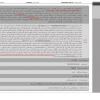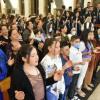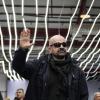
By The Free Iranian Staff
With the Khomeinist Regime’s Supreme Leader, Ali Khamenei, now being 80 years old, and having a history of health problems, the highest-ranking regime leaders are now scheming against each other to attain the highest prize to be gained in Tehran. Whoever becomes the next Supreme Leader will not only be the absolute dictator over Iran, as stipulated in the regime’s constitution, but will also control a $200 billion financial empire, the fruits of four decades of the regime’s corruption and expropriations. Thus, the race to succeed Khamenei may soon become the biggest factor in internal regime politics.
The Proceedure
As the Islamic regime is by no means close to a democratic republic, the Iranian public has no say over who will be their next all-powerful ruler. Theoretically, the Supreme Leader is selected by the Assembly of Experts, an 88-member body of Shi’a Islamic clerics, elected by the people of Iran from carefully vetted list of candidates chosen by the Guardian Council (another committee of clerics). In practice, however, the Assembly of Experts has never had any real power, and is more of a ceremonial committee that affirms decisions already made elsewhere. The only previous transition of power in the Islamic regime, that from Ayatollah Khomeini to Khamenei, was decided behind closed doors by the major figures within the regime at that time. Khamenei did not even have the qualifications for supreme leadership demanded by the Islamic constitution at that time, and had to be granted a special exemption by the Assembly. (Which is one reason why he has pushed the Assembly of Experts to the side during his 30-year reign) Therefore, if Khamenei does not name a successor while he is alive, and even if he does, the choice of the next supreme leader will have to be agreed upon by the leaders of the various factional groupings within the regime. Today, with the most powerful organ in Tehran being the Islamic Revolutionary Guards Corps (IRGC), which, in addition to being the primary muscle affirming the regime’s power, also controls a huge economic empire of its own, the IRGC will be the ultimate decider of who rules after Khamenei, that is, if the IRGC generals can agree on a single choice. Of the names currently thrown about in the media as possible future supreme leaders, the three most commonly repeated are: Mojtaba Khamenei, the current leader’s eldest son; Sadeq Larijani, a member of an extremely wealthy and powerful political family; and Ebrahim Raisi, an Islamist lawyer and longtime enforcer of harsh punishments towards dissidents.
Mojtaba – Papa’s Favorite Son
The 50-year-old Mojtaba Khamenei has been described as powerful man in his own right, behind-the-scenes, for at least a decade. His father is often alleged to be grooming him as his replacement, despite the fact that Mojtaba is a low-level cleric, and, as with his father before him, does not have the qualifications for Supreme Leadership according to the Islamic constitution. In 2009, Mojtaba was said by regime insiders to have orchestrated the rigged re-election of Mahmoud Ahmadinejad, and to have personally commanded the IRGC’s Basij militia as it brutally repressed the protests in the aftermath of that election. Nonetheless, Mojtaba has made many enemies even within the regime hierarchy due to his flagrant amassing of personal wealth. The younger Khamenei is known to be a billionaire in his own right. In 2012, his former ally Ahmadinejad publicly mentioned Mojtaba’s embezzling of $1.6 billion from the state oil revenues, depositing the looted cash in British bank accounts that were frozen in 2009. Other insiders have accused Mojtaba of taking bribes from businessmen, in addition to embezzling. According to a 2016 article in the Arabic newspaper Al Quds Al Arabi, based on information provided by the rival Rafsanjani family, Mojtaba has “three billion dollars, most of which was deposited in banks in the UAE, Syria, Venezuela and some African countries.” Other estimates of his wealth go even higher, such as one from 2011 stating he has “in England £ 1.14 billion (2 accounts frozen since 2009), Germany, 2.12 billion Euros (4 accounts), Qatar $400 million, S. Africa, 950 million Euros (2 accounts), UBS/Micheloud & Cie/Credit Suisse, 12 accounts adding to 3.85 billion Euros, Liechtenstein $ 2.8 billion, S. Africa $620 million, Shanghai $4.1 billion, UAE: $ 700 million, Malaysia A$670 millions.
Larijani – The Operator
As head of the regime’s judiciary from 2009 until March of this year, Sadeq Larijani is responsible for the executions, tortures, and imprisonments of those arrested during the Green Movement in the summer of 2009, as well as the subsequent waves of protest, including the most recent one that commenced in the winter of 2017. 58 years old and born in Najaf, Iraq, Larijani is another low-ranking cleric whose success in riding to the top of the regime hierarchy was based on his and his family’s personal subservience to Khamenei. In 2015, he stated that the Assembly of Experts has no right to question Khamenei’s actions, despite the Islamic constitution having created it to do so; and in 2016, he publicly warned regime president Rouhani against speaking too out-of-line with what Khamenei wants said. In January, 2018, the US government sanctioned Larijani for his human rights abuses, which it described as including the execution of juveniles and torture of prisoners, including limp amputations. Larijani is also known for the corruption and wealth he and his brothers have been accumulating, and has been attacked for this by some of his rivals within the regime, including his successor as judiciary chief, Raisi.
Raisi – The Attack Dog
Ebrahim Raisi, who currently is promoting his image by trying to appeal to workers and other disenfranchised Iranians, succeeded Larijani as head of the regime’s judiciary this March. He has been a loyal sycophant to Khamenei for years, with his most immediate post prior to his current being custodian of the Imam Reza Shrine in Mash’had (Astan Qodz Razavi), one of the three main foundations/conglomerates serving as holding companies for Khamenei’s wealth. He also has close ties to the IRGC. Before that, he served Khamenei as a prosecutor, and then a judge, being implicated in numerous human rights violations, the most notable of which being the 1988 massacre of 30,000 political prisoners. He also is a low-ranking cleric, not an ayatollah, though he has previously falsely claimed to be one.
The Future of Iran Does Not Depend on The Regime
Regardless of who triumphs, if anyone, at the end of all the internal maneuverings, the people of Iran have had enough at being excluded from the governance of their own country. The current wave of anti-regime protests, which has continued since December, 2017, despite the harsh suppression exerted by the clerics and the IRGC is proof that Iranians want to end not only the political dictatorship of the clerics, but also the corrupt economic dominance of the regime leaders that has impoverished them. The inevitable infighting and competing for power that will ensue when Khamenei either dies, or becomes incapacitated, will provide the Iranian people an opportunity, perhaps, to finally rise up and overthrow the regime when it is disunited and at its weakest point. By not taking measures to improve the Iranian people’s living standards, and offering them more opportunities to express their views and participate in their nation’s political life, Khamenei and his coterie of would-be replacements are only further leading the Islamic regime towards its inevitable collapse.










